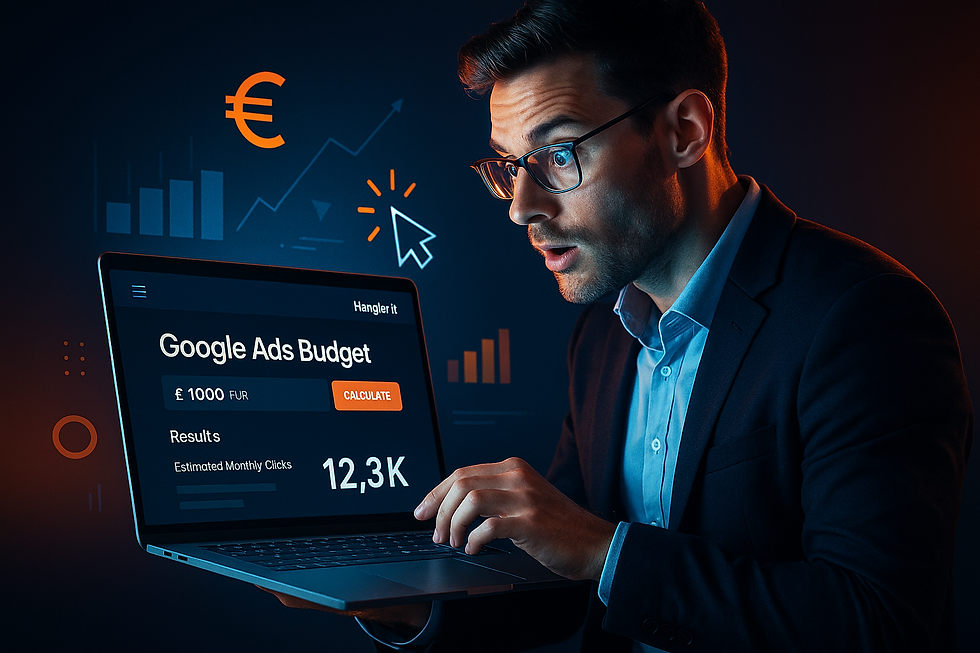How much does it cost to do digital marketing for an SME?
- Redazione

- May 6
- 4 min read

When talking about digital marketing, many still think of posts on Facebook or Instagram.
But today, for a small or medium-sized business, doing online marketing means much more : it means building a sales funnel, activating targeted advertising campaigns, analyzing data, optimizing the user experience and improving your visibility in search engines.
It is the mix of activities and skills that gives results, and a single "acquisition channel" is increasingly less sufficient.
This article tries to give real information based on real companies in the Italian context. If you want to understand in detail what the best budget and organizational structure for your business can be, we recommend you read this book:

Summary
Digital marketing ≠ social media only
But let's get back to us: an effective digital strategy today includes:
Structured lead generation
Technical and content-based SEO (soon also aimed at AI spiders)
Multi-channel advertising campaigns (Meta, Google, Microsoft, LinkedIn)
Email Marketing & CRM
Targeted content creation to fuel campaigns with fresh creative and avoid message addiction
Data analysis and continuous testing
And all this comes at a cost. But how much does it really cost?
The two main voices: management and advertising
🧠 1. Management costs
These are the recurring costs of maintaining and operating the entire digital ecosystem. They can include:
Internal resources or external agency (be careful: even if you use a web agency, you need to plan some internal staff time to manage it and give it answers and content)
Staff training and updating (on sometimes complex and constantly evolving topics)
Content production (copy, photos, videos, design)
Software and tools (CRM, automation, analytics platforms)
💡 Indicative estimate for SMEs: from €1,000 to €3,500 per month (variable based on complexity, number of channels and resources involved)
💰 2. Advertising costs
These are advertising investments on platforms such as:
Google Ads
Meta Ads (Facebook, Instagram)
Microsoft Ads (Bing)
LinkedIn Ads
Off-site SEO Link Building
Other useful channels for the specific context
These costs are completely variable and must be adapted to the sector, competitiveness and geographical radius.
🔍 Real examples of advertising budgets (average daily costs)
Sector | Area of activity | Meta Ads (€) | Google Ads (€) | Microsoft Ads (€) |
Local B2C | Multi-provincial | 60 | 55 | 10 |
Energy/Photovoltaic | Regional | 335 | 244 | - |
Industrial services | Multi-regional | 95 | 59 | 10 |
Technical B2B | Multi-provincial | 10 | 40 | - |
E-commerce courses | National | 100 | - | 10 |
Sports association | Provincial | 22 | 16 | - |
Commodities | Regional | 200 | 184 | 85 |
👉 Total monthly range (ADV only): from €300 to over €10,000 (depending on market, area covered and ambition)
📈 How much do SMEs that achieve concrete results invest?
SMEs that achieve measurable results over time are those that:
They invest at least €1,500–2,000 per month on an ongoing basis
They allocate the budget in a balanced way between strategy, content and campaigns
They don't focus everything on a single channel (e.g. just Instagram or just Google)
They accept an initial period of testing and optimization, without expecting immediate returns
🎯 In short: more than “how much you spend”, it matters how you invest , how often and on what strategic basis.
📊 How to correctly interpret a digital marketing investment
Many SMEs approach digital marketing by asking themselves:
“If I invest 1,000 euros, how much do I earn?”
But the return is never immediate. You need to think in terms of margin , conversion and above all Lifetime Value (LTV) .
1. Lead generation: positive margin = solid foundation
Example:
Budget: €800
Leads generated: 20 (Cost Per Lead: €40)
Conversion: 20% → 4 customers
Average revenue: €300 , net margin €150→ Total recovered: €600
At an initial loss, but only if customers don't return .
2. The Lifetime Value (LTV)
If each customer brings in €900 over time, those €40 spent to acquire them become an extremely profitable investment .
👉 The higher the LTV, the more you can afford to spend per lead. In this sense, loyalty and cross-selling / up-selling strategies are also needed.
3. E-commerce and ROAS
Example:
Ads: 1.000 €
Sales: €4,000 → ROAS 4xBut once costs are removed (products, logistics, returns), the net profit can drop to €1,400 → ROI +40%
High ROAS is not enough: you also need to know the margin, average receipt, purchase frequency.
📐 Recommended LTV and CPL table by sector
Sector | Estimated average LTV (€) | Maximum recommended CPL (€) | Ideal conversion rate |
B2B Professional Services | 1,500 | 300 | 20–30% |
High Margin Niche E-Commerce | 500 | 100 | 3–5% |
Generic e-commerce (consumer) | 150 | 30 | 1–2% |
Online Courses / Training | 800 | 150 | 8–10% |
Local services (windows, aesthetics) | 700 | 100 | 10–15% |
Sports Association / Non-profit | 100 | 10 | 15–20% |
📜 Official sources and references
IAB Europe – Digital Ad Spend Report
ISTAT – Business and ICT (2023)
AGID – Guidelines on digital communication
Hangler Marketing Advisor internal data on Italian SMEs in different sectors and territories
Do you want a personalized estimate?
If you are considering an investment in digital marketing for your company, let's start with an analysis: 🎯 Clear objectives, available resources, markets to cover. Book a call 👇🏻



Comments